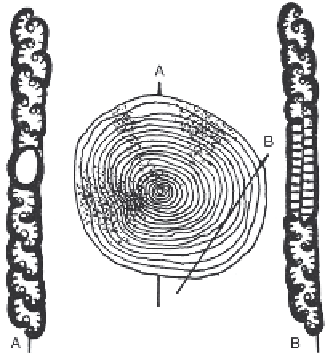Geology Reference
In-Depth Information
Plate 71 Cretaceous Platform Carbonates: Benthic Foraminifera
Thin sections of many Cretaceous platform carbonates are rich in benthic foraminifera, allowing generic or
specific identification. Benthic foraminifera are particularly useful for biostratigraphic zonations of Tethyan
shallow-marine carbonates (Becker 1999).
These biozones exhibit a general trend with regard to the superposition of the zones, but may include differ-
ent parts of chronostratigraphic units, owing to different paleoenvironmental conditions and regional fluctua-
tions of sea level and subsidence. Conical tests exhibiting chambers subdivided by many septulae and belonging
to the textulariid family Cuneolinidae (superfamily Ataxophragmiacea) are index fossils in Early Cretaceous
carbonates (-> 1-5, 8, 11).
1
Vercorsella camposauri
(Sartoni and Crescenti). Textulariina, Ataxophragmiacea. Transversal-oblique section. The chamber
interior is subdivided by radial vertical partitions. Wall agglutinated with fine calcite cement.
Vercorsella camposauri
and
Vercorsella scarsellae
(-> 2) characterize an Early Aptian biozone. Genus range: Late Hauterivian to Early Aptian.
Barremian-Early Aptian (Berdiga limestone): Kircaova south of Trabzon, northern Turkey.
2
Vercorsella scarsellai
(de Castro). Transverse section.
Vercorsella
characterizes the inner platform environment. Same
locality as -> 1.
3
Vercorsella laurentii
(Sartoni and Crescenti). Longitudinal-tangential section. Same locality as -> 1.
4
Vercorsella laurentii
(Sartoni and Crescenti). Axial section. Same locality as -> 1.
5
Sabaudia minuta
(Hofker). Textulariina, Ataxophragmiacea. Subaxial longitudinal section. Wall agglutinated, imperfo-
rate. Small conical test. Trochospiral initial stage with inner microgranular and outer hyaline layer. The biserial chambers
are subdivided by vertical partitions forming a network of chamberlets. Genus range: Late Hauterivian to Aptian. Late
Aptian: Padurea Craiului, Apuseni Mountains, Romania.
6
Dictyoconus algerianus
Cherchi and Schroeder. Textulariina, Orbitolinacea. Axial section. Conical test, dish-like cham-
bers with typical convex base. Late Aptian-Early Cenomanian: Gebel Maghara, Sinai, Egypt.
7
Dictyoconus algerianus
Cherchi and Schroeder. Oblique section showing the vertical partitions of the marginal zone
(arrows). Same locality as -> 6.
8
Cuneolina
ex gr.
pavonia
d'Orbigny. Textulariina, Ataxophragmiacea. Conical test. As shown in this oblique axial sec-
tion the broad and low chambers are subdivided into chamberlets. Cuneolinid foraminifera are abundant in shallow inner
platform deposits associated with miliolinid foraminifera. Genus range: Valanginian to Coniacian. Same locality as -> 6.
9
Reophax giganteus
Arnaud. Textulariina, Hormosinacea. Longitudinal section. Free, elongated test with few chambers.
The coarsely agglutinated wall consists of ooids (O) and foraminiferal debris (FD). The genus is known from the Middle
Ordovician to the Holocene. Early Cretaceous: Subsurface, Hohenlinden-1 well, Molasse zone, Bavaria, Germany.
10
Choffatella decipiens
Schlumberger. Textulariina, Loftusiacea. Transversal equatorial section. Planispiral, enrolled test.
The wall is differentiated into a peripheral network (top right). The endoskeleton exhibits thick septa pierced by pores.
Genus range: Late Jurassic (Oxfordian) to Late Cretaceous (Cenomanian). Common in the Barremian to Aptian time
interval. Early Cretaceous: Spain.
11
Dicyclina
Munier-Chalmas. Textulariina, Ataxophragmiacea. Axial section. The interior of the discoidal test is subdi-
vided by numerous thin radial partitions, perpendicular to the outer wall and aligned from chamber to chamber. The
maximum spreading of the
Dicyclina
microfacies took place during the Coniacian and the Turonian. Senonian: Subsur-
face, Ras al Khaimah, United Arabian Emirates.
12
Reophax giganteus
Arnaud. Transverse sections. Walls are coarsely aggluti-
nated. Early Cretaceous: Subsurface, Hofolding-1 well, southern Bavaria,
Germany.
13
Rhapydionina liburnica
(Stache)
.
Miliolina, Milioliacea. Longitudinal sec-
tion. Genus range: Cenomanian to Maastrichtian. Senonian: Mesarlek, south-
ern Turkey.
14
Rhapydionina liburnica
(Stache). This species often dominated an oligotypic
assemblage of upper Late Cretaceous inner platform environments charac-
terized by restricted water circulation. Axial section. Same locality as -> 13.
Left figure: Schematic sections of
Dicyclina
. Center: planispiral test.
A
: Axial
section passing through the initial chamber.
B
: Subaxial section exhibiting
several peripheral chambers and radial partitions in the central part of the shell.
After Neumann (1967).
->1-4: Kirmaci et al. 1996; 5: Courtesy of I. Bucur (Cluj-Napoca); 6-8: Kuss
and Schlagintweit 1988

